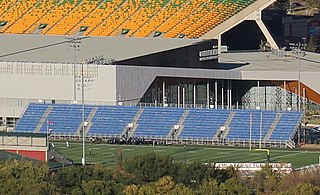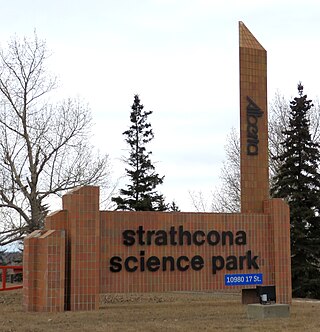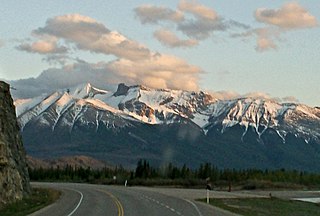
Edmonton is the capital city of the Canadian province of Alberta. Edmonton is situated on the North Saskatchewan River and is the centre of the Edmonton Metropolitan Region, which is surrounded by Alberta's central region. The city anchors the north end of what Statistics Canada defines as the "Calgary–Edmonton Corridor".

The Edmonton Trappers were a minor league baseball team in Edmonton, Alberta. They were a part of the Triple-A level in the Pacific Coast League, ending with the 2004 season. Their home games were played at Telus Field in downtown Edmonton.

RE/MAX Field is a baseball stadium in Edmonton, Alberta, Canada. It has served as home to several minor league baseball clubs; its last affiliated tenant was the Edmonton Trappers, a AAA Pacific Coast League club. It was also home to the Edmonton Capitals, an independent team that has been inactive since 2011. The Edmonton Prospects of the Western Canadian Baseball League (WCBL) were the main tenant from 2012 to 2019. The ballpark was mostly unused in 2020 and 2021 because of the COVID-19 pandemic, but the Edmonton Riverhawks of the West Coast League will be the main tenants starting in 2022. The facility is located in the North Saskatchewan River Valley, in the neighbourhood of Rossdale.

Clarke Stadium is a multipurpose facility located in Edmonton, Alberta, Canada. The stadium was originally used for Canadian football. Over the years different sports have participated at the site. Presently, it is the home of the Edmonton Huskies and the Edmonton Wildcats of the Canadian Junior Football League.
University of Alberta Press is a publishing house and a division of the University of Alberta that engages in academic publishing.
John Patrick Gillese was an Irish-born Canadian author whose prolific career spanned six decades from the early 1940s to the late 1990s. During this period he authored over 5,000 pieces including novels, short stories, and information columns that were published in many English-speaking countries.
John Ducey Park was a 6,500-seat baseball stadium in Edmonton, Alberta, Canada. Originally built in 1933, it was torn down after sixty years of use in 1995 and replaced by Telus Field on the same site. Beginning in 1981, John Ducey Park was the home field for the AAA Edmonton Trappers of the Pacific Coast League.
Alice Major is a Canadian poet, writer, and essayist, who served as poet laureate of Edmonton, Alberta. During her tenure as poet laureate, she founded the Edmonton Poetry Festival in 2006. She continues to serve on the Board of Directors for the Edmonton Poetry Festival Society as President.
Lloydminster Meridians was a baseball team in Lloydminster, Alberta, Canada that played along with the Edmonton Eskimos and the Edmonton Drakes.
Leroy Delano "Goldy" Goldsworthy was an American ice hockey forward. He played in the National Hockey League between 1929 and 1939.
Rundle Heights is a residential neighbourhood overlooking the North Saskatchewan River valley in the City of Edmonton, Alberta, Canada, named for Methodist missionary Robert Terrill Rundle. While the neighbourhood didn't develop until the 1960s and 1970s, the area is closely associated with the Town of Beverly, a working class community that amalgamated with Edmonton in 1961. A number of the Beverly coal mines were located in the area.

Strathcona Science Provincial Park is a provincial park in Alberta, Canada, located between Edmonton and Sherwood Park, south of the Yellowhead Highway and west of Anthony Henday Drive.
Cameron Heights is a neighbourhood in west Edmonton, Alberta, Canada overlooking the North Saskatchewan River valley.
Kingsway, sometimes called Kingsway Avenue, is an arterial road in central Edmonton, Alberta, Canada, that runs on a northwest to southeast path, cutting through the city's normal grid pattern. It skirts just to the south of Edmonton City Centre Airport, and connects to Kingsway Mall and the Royal Alexandra Hospital.

Utopia Mountain is a 2,602-metre (8,537-foot) mountain located in the Miette Range of Jasper National Park, in the Canadian Rockies of Alberta, Canada. It was named by Morrison P. Bridgland in 1916. Bridgland (1878-1948) was a Dominion Land Surveyor who named many peaks in Jasper Park and the Canadian Rockies.
Dungeon Peak is a 3,129-metre (10,266 ft) mountain summit located on the shared border of Jasper National Park in Alberta, and Mount Robson Provincial Park in British Columbia, Canada. Dungeon Peak is part of The Ramparts in the Tonquin Valley. The descriptive name was applied in 1916 by Morrison P. Bridgland (1878-1948), a Dominion Land Surveyor who named many peaks in Jasper Park and the Canadian Rockies. The mountain's name was made official in 1935 by the Geographical Names Board of Canada.
The following is a bibliography of Alberta history.

Cinquefoil Mountain is a 2,256 m (7,402 ft) mountain summit located in the Athabasca River valley of Jasper National Park in Alberta, Canada. It is situated in the Jacques Range of the Canadian Rockies. Cinquefoil Mountain was named in 1916 by Morrison P. Bridgland on account of cinquefoil in the area. Bridgland (1878-1948) was a Dominion Land Surveyor who named many peaks in Jasper Park and the Canadian Rockies. The mountain's name was officially adopted in 1928 by the Geographical Names Board of Canada.

Mount Greenock is a 2,073-metre (6,801 ft) mountain summit located in the Athabasca River valley of Jasper National Park in Alberta, Canada. It is situated in the De Smet Range of the Canadian Rockies. It was named in 1916 by Morrison P. Bridgland after Greenock, in Scotland. Bridgland (1878-1948) was a Dominion Land Surveyor who named many peaks in Jasper Park and the Canadian Rockies. The mountain's name was officially adopted in 1956 by the Geographical Names Board of Canada.








